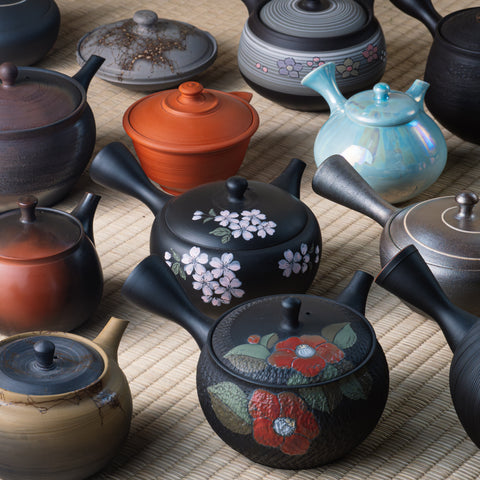
Though only developed in the late 1800s, the unglazed brick-red kyusu has become synonymous with Tokoname-yaki. Despite this, this ancient pottery town in Aichi Prefecture boasts a rich variety of clays, designs, and finishes used to make its famous teaware. Here are some of the most popular:
Tokoname Clay Types
Perhaps the most important factor in deciding teaware's final feel, functionality, and appearance is the clay from which it is made. As the majority of Tokoname ware is unglazed, the clay itself determines the final finish of the piece.
Shudei (朱泥 - vermilion clay)
This iconic fine-grained clay of Tokoname ranges from a bright scarlet to a softer orange red. Originally, Tokoname Shudei was made from the soil that once lay at the bed of the prehistoric Lake Tokai. Now called honshudei (本朱泥 - real/true shudei), this original clay was praised for its positive effects on the taste of tea and was used to make domestic teapots in imitation of Chinese Yixing ware in the 19th century. Nowadays, honshudei has become rare and many potters use more modern formulations that approximate its taste and colour. Shudei’s iconic hues come from its relatively high iron content. When fired in an oxidising atmosphere (also called ‘firing in oxidation’, i.e. there is enough oxygen supply to allow complete combustion, turning the fuel into water and carbon monoxide), the iron compounds oxidise and turn a bright red-orange.

Some artists still use hon-shudei, including Maekawa Junzō. His stock of hon-shudei clay has been stored for over 40 years in Gifu prefecture. Compared to most moden shudei, it has a softer colour and is a little coarser in texture.
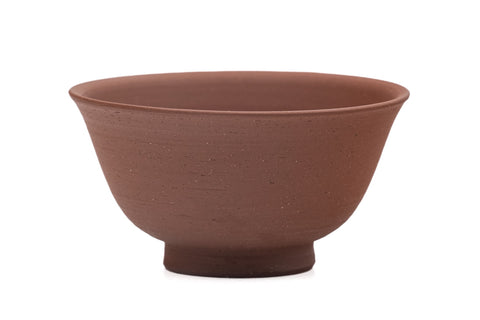
Kokudei (黒泥 - black clay)
Generally speaking, there are two types of kokudei. The first is simply clay that has been dyed black, while the other is actually shudei, but fired in reduction. Unlike an oxidising atmosphere, a reducing atmosphere has limited oxygen, meaning there is only incomplete combustion, producing carbon monoxide (CO) instead of carbon dioxide (CO2). This unstable CO reacts with oxygen-containing iron compounds in the clay to form CO2, thereby reducing these compounds (removing oxygen from them) and changing their colour, usually to a dark brown or black. Additionally, reduction firing can produce a lot of soot and smoke which adds to the darkening of the clay.

Ryokudei (緑泥 - green clay)
This striking green clay gets its colour from added cobalt, which turns the clay green when fired in oxidation. Ryokudei clays can vary greatly in hue and saturation, ranging from deep forest greens to subtle green-greys.

Koudei (黄泥 - yellow clay)
A less common clay, koudei is stained anywhere from a soft ivory to a vibrant yellow.
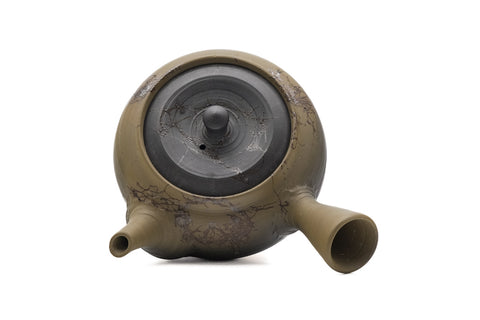
Nerikomi (練り込み - kneading)
Nerikomi is not technically a type a clay but rather a technique in which various coloured clays are kneaded together to form beautiful marbling patterns that resemble agate. Sometimes just two colours are used to produce bolder spiralled designs, while other times up to 4 or 5 clays are used to produces a more intricate effect. This technique is often accented with cuts made into the surface of the vessel, revealing the layers of patterns and marbling.

Yakishime (焼締 - rough unglazed stoneware)
This relatively unprocessed clay has a coarser texture when compared to the fine-grained shudei, giving the finished pieces a rougher surface. Like most Tokoname clays, yakishime is fired without a glaze, which showcases it unique texture. Yakishime is often wood-fired, which can produce various kiln effects.

Finishes and Decorations
Apart from the engraving, inlay, and painting techniques that are common in many Japanese ceramic production regions, Tokoname has a few that are unique and seldom found elsewhere.
Yōhen (窯変 - kiln change)
Yōhen is used to generally describe many kiln effects across various ceramics styles (including Tenmoku, where it is spelled 曜変). In Tokoname-ware, however, this term specifically refers to the attractive and often dramatic colour gradients and patches caused by certain firing conditions. One way this is achieved is by partially submerging the teapot in sawdust while firing. Yōhen pots typically have a gradient from a dark black or brown to shudei red, though some potters use this technique with ryokudei or koudei clays to produce unique colour patterns. As the exact pattern produced is highly dependent on the position of the piece in the kiln as well as the firing temperature, atmosphere, and fuel, producing a consistent result across many pieces takes a great amount of skill, patience, and practice.

Tochiri (トチリ)
Also known as tobikanna (トビカンナ), this pattern of fine diagonal lines is made by scraping the surface with a razor blade while the piece is spinning on the wheel. This kyusu by Gyokko combines a yōhen firing with tochiri surface decorations
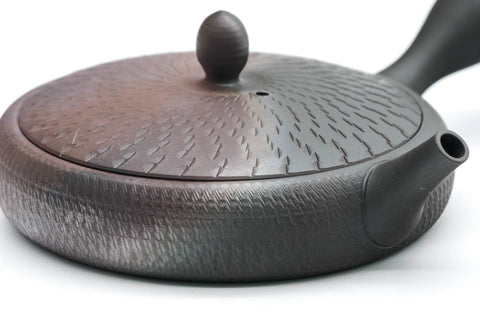
Kushime (櫛目)
Another style of surface decoration, kushime or comb marks are engraved parallel lines formed by scraping a comb-like tool through the clay's surface. Simple and elegant, this technique adds a layer of texture and intrigue to a pot without being loud or overwhelming.
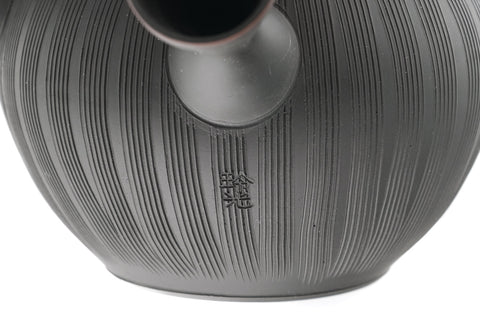
Matsugawa (松皮)
Another method of adding surface texture popular in Tokoname is called matsugawa or pine bark. A small wheel is used that leaves behind a rough texture reminiscent of the bark of a pine tree, giving this style its name.
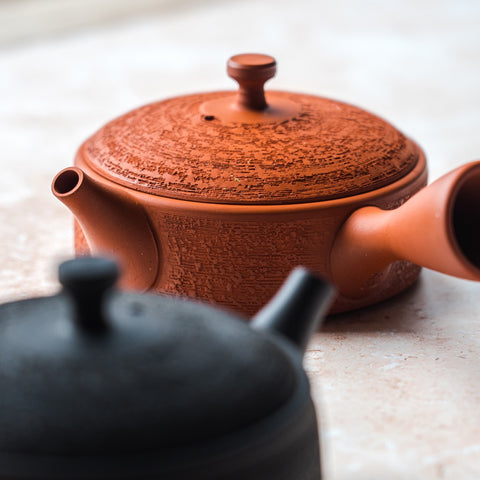
Mogake (藻掛)
Meaning 'seaweed wrapping', this traditional Tokoname technique dates back to the Edo period and is achieved by wrapping each piece with amamo seaweed before firing. In the kiln, the seaweed burns off, leaving its carbonised silhouette draped across pot. Due to the natural nature of seaweed, each piece of mogake decorated pottery will have its own unique pattern.

Benishibori (紅しぼり)
A substyle of the mogake technique, benishibori makes use of a brown clay fired in reduction. As a result, instead of dark seaweed marks on a red or gray clay, the pattern is much more subtle.
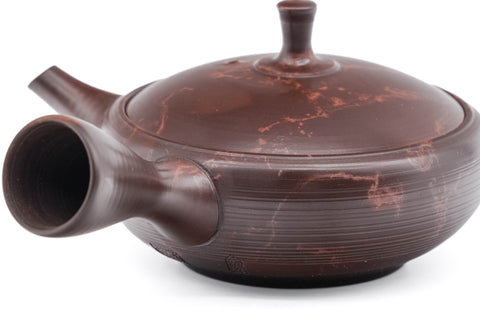
Shudashi (朱出し)
Literally meaning 'vermillion out', this technique requires kokudei wares made in the second method as described above. That is to say, shudei clay fired in reduction, where it is covered in soot. After firing, a thin layer of the blackened clay is scraped off, revealing the brilliant vermillion of the shudei clay underneath
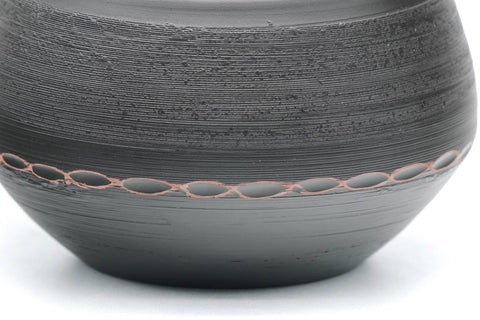
Sujibiki/Sujihiki (筋引)
In this rustic style, the surface is unpolished and unsmoothed, revealing the flow of the potter's fingers as they shaped the piece on the wheel. Outside of Tokoname ware, similar styles are often called rokurome (ろくろ目 - potters' wheel marks), however sujibiki tends to be more subtle.
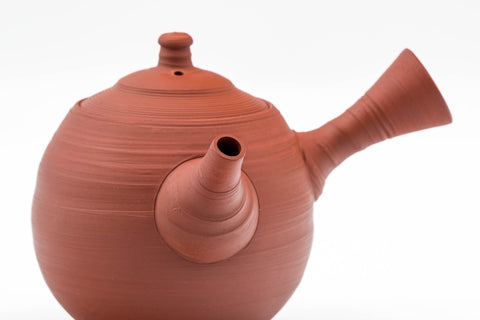
Browse our unique selection of Tokoname-yaki teaware.


